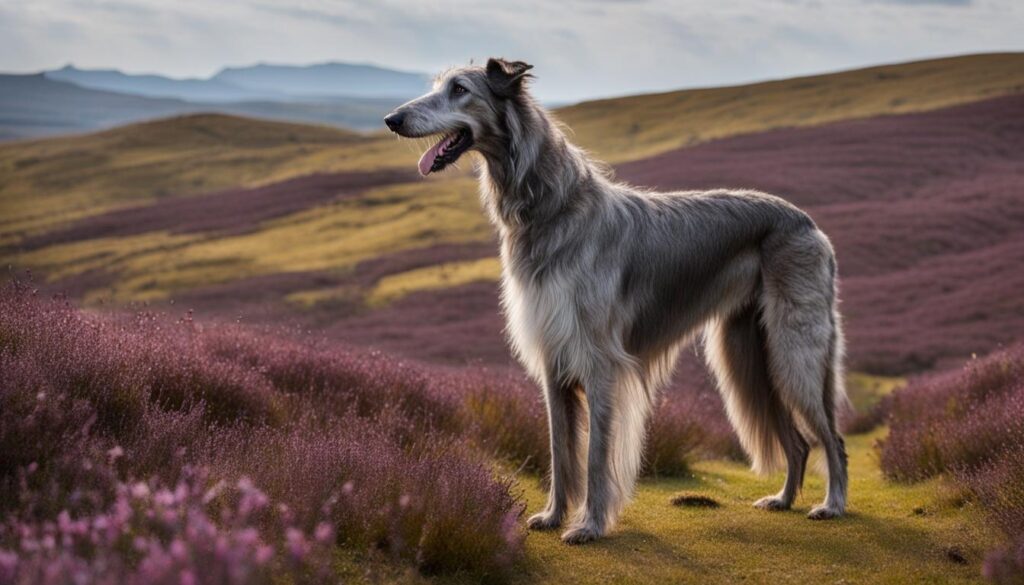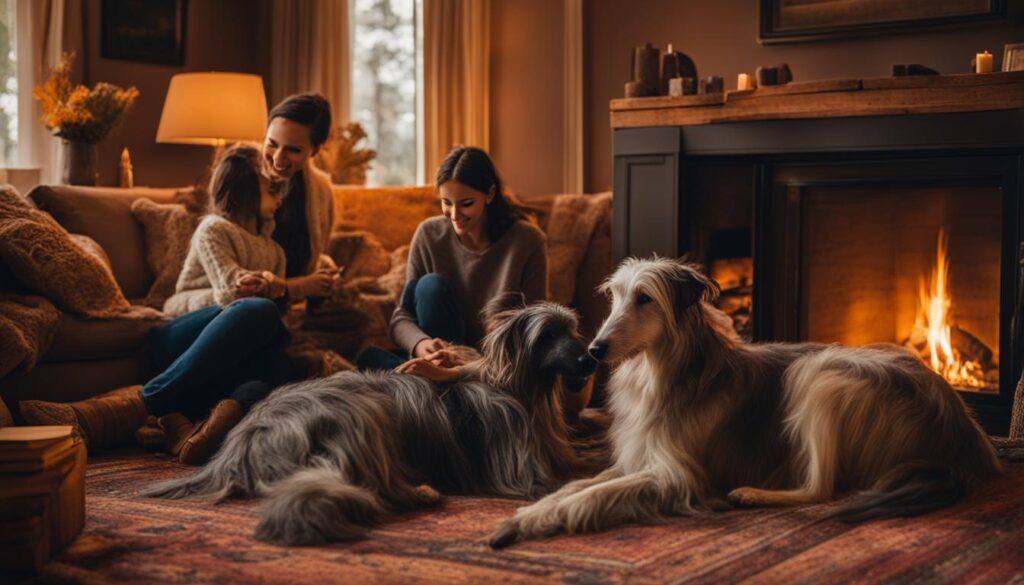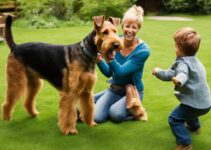As a professional journalist, I am excited to introduce you to the magnificent Scottish Deerhound, also known as the Deer Hound. This ancient breed has captured the hearts of dog enthusiasts for centuries with its regal appearance, remarkable hunting skills, and gentle temperament. In this ultimate guide, I will provide you with all the essential breed information, including their characteristics and temperament, ensuring that you have a comprehensive understanding of this majestic canine companion.
Key Takeaways:
- The Scottish Deerhound is an ancient breed known for its endurance, speed, and hunting skills.
- They have a rich history dating back to at least the 16th century and were bred to hunt giant, wild red deer.
- Scottish Deerhounds are one of the largest dog breeds, reaching heights of up to 32 inches at the shoulder.
- They have a gentle temperament and make excellent family pets but require plenty of exercise and mental stimulation.
- Regular grooming, dental care, and veterinary check-ups are crucial for their overall health and well-being.
The History of the Scottish Deerhound
The Scottish Deerhound is an ancient and noble breed with a rich history. Its origins can be traced back to the third century, but it was in the 16th and 17th centuries that it became definitively known as the Deerhound. These dogs were bred to hunt giant, wild red deer in the Scottish Highlands, and they were highly valued as royal dogs.
During this time, ownership of Scottish Deerhounds was restricted to those of noble rank, which contributed to the breed’s exclusivity. However, this exclusivity almost led to the breed’s extinction. Fortunately, in the 19th century, breeders such as Sir Walter Scott played a crucial role in reviving the breed and ensuring its survival.
Today, the Scottish Deerhound is still a rare and sought-after breed. It is admired for its hunting instincts, loyalty, and companionship. While ownership restrictions no longer apply, the breed’s history and heritage continue to be cherished by enthusiasts and owners alike.
Hunting and Ownership Restrictions
One of the distinguishing characteristics of the Scottish Deerhound is its hunting ability. These dogs were specifically bred to pursue and capture swift prey, such as deer. Their speed, stamina, and keen senses make them exceptional in the field, and their hunting skills have been treasured for centuries.
Additionally, it is worth noting that the Scottish Deerhound was historically owned exclusively by those of noble rank. These ownership restrictions added to the breed’s allure and made them a symbol of status. While these restrictions no longer apply, they are an important part of the Deerhound’s history and heritage.
Today, Scottish Deerhounds are beloved companions and cherished for their gentle and sociable nature. Whether as hunting partners or loyal family pets, these dogs continue to captivate the hearts of those who have the privilege of sharing their lives with them.
Characteristics of the Scottish Deerhound
The Scottish Deerhound is truly a magnificent breed, known for its impressive size and regal appearance. With adult males weighing between 85 to 110 pounds and standing at a height of 28 to 32 inches at the shoulder, these gentle giants command attention wherever they go.
Temperament-wise, the Scottish Deerhound is a true gem. They have a gentle and sociable nature, making them excellent family pets. Their loyalty knows no bounds, and they form strong bonds with their human companions. However, it’s important to note that they do require plenty of exercise. These dogs love to run and chase, so regular opportunities for free exercise are essential for their overall well-being.
Size and Temperament
The size and temperament of the Scottish Deerhound make them a unique and cherished breed. Their calm disposition indoors makes them wonderful housemates, but they are still active dogs that need mental and physical stimulation to thrive. Their size does require some consideration, especially in homes with smaller children, but with proper supervision and training, they can be a loving and loyal addition to any family.
In summary, the Scottish Deerhound is a stunning breed that combines regal grace with a gentle and sociable temperament. Their impressive size, loyalty, and need for exercise make them a unique choice for dog lovers. If you’re looking for a majestic companion who will capture your heart, the Scottish Deerhound is an excellent choice.

Training and Grooming the Scottish Deerhound
Training and grooming are essential aspects of caring for a Scottish Deerhound. These gentle giants are sensitive dogs, so training should be approached with patience and positive reinforcement. By using reward-based methods and consistency, you can effectively train your Deerhound to be well-behaved and obedient.
Regular exercise is crucial for the physical and mental well-being of a Scottish Deerhound. These dogs have a high energy level and enjoy being active. Providing them with daily opportunities for exercise, such as long walks or free runs in a securely fenced area, will help prevent boredom and destructive behavior.
Grooming a Scottish Deerhound is relatively low-maintenance compared to other breeds. They have a wiry or rough coat that requires a weekly brushing to remove loose hair and prevent matting. Additionally, their teeth should be brushed regularly to maintain good oral hygiene, and their nails should be trimmed as needed. Regular visits to the veterinarian for check-ups and professional dental cleanings are important for their overall health.
Health Concerns for Scottish Deerhounds
When it comes to the health of Scottish Deerhounds, there are a few important considerations to keep in mind. One of the primary health issues that can affect these majestic dogs is bloat, which is a potentially life-threatening condition. Bloat occurs when the stomach fills with gas and twists, leading to a blockage of blood flow to the heart and other vital organs. Immediate veterinary attention is crucial if bloat is suspected.
Another health concern to be aware of in Scottish Deerhounds is dilated cardiomyopathy. This is a condition that affects the heart and can lead to an enlarged heart and heart failure. Regular veterinary check-ups and diagnostic tests can help monitor and manage the health of these dogs.
Preventing health issues in Scottish Deerhounds
To help prevent these health issues and promote overall well-being in Scottish Deerhounds, there are several steps you can take. Firstly, provide them with a balanced and nutritious diet that meets their specific dietary needs. This can help maintain a healthy weight and support their overall health. Regular exercise is also important, as it helps keep them fit and mentally stimulated.
Additionally, regular veterinary check-ups are essential for early detection and management of any potential health concerns. These check-ups allow your veterinarian to monitor your dog’s overall health, assess any potential genetic predispositions, and provide necessary preventive care.
By taking these proactive steps and providing the necessary care and attention, you can help ensure that your Scottish Deerhound remains healthy and happy for years to come.
Scottish Deerhounds as Family Companions
Scottish Deerhounds are renowned for their gentle and sociable nature, making them excellent family companions. Their compatibility with children and other pets, when properly socialized, adds to their appeal as family pets. These majestic dogs form strong bonds with their human family members and thrive on social interactions.
Their calm and composed demeanor makes them well-suited for family environments. However, it’s important to supervise interactions between younger children and larger dogs, as the Deerhound’s size can accidentally knock over small children. With proper training and socialization, Scottish Deerhounds can become loving and protective members of the family.
One of the key qualities of Scottish Deerhounds is their sociability. They generally get along well with children and have a patient and tolerant nature. Their gentle temperament and loyalty make them an ideal choice for families looking for a gentle and friendly companion.

Training and Socialization
Training and socialization play a crucial role in shaping Scottish Deerhounds into well-behaved and friendly family companions. Early socialization exposes them to a variety of people, animals, and environments, helping them develop good manners and a well-rounded personality. Positive reinforcement training methods, such as rewards and praise, work best with these sensitive dogs.
Regular exercise is also important to keep Scottish Deerhounds happy and content. They need opportunities to stretch their legs and run freely in a safe and enclosed space. Providing mental stimulation through interactive toys, puzzles, and games can also help prevent boredom and destructive behavior.
In conclusion, Scottish Deerhounds are sociable and gentle family companions that bring joy and companionship to their owners. With proper training, socialization, and care, these majestic dogs can thrive in a family environment and become beloved members of the household.
Caring for a Scottish Deerhound
When it comes to caring for a Scottish Deerhound, providing the right nutrition is essential for their overall health and well-being. A high-quality dog food that is age-appropriate and monitored to prevent weight gain is important. It’s also crucial to ensure they have access to clean water at all times.
Exercise is another key aspect of caring for a Scottish Deerhound. These dogs are active and require regular physical activity to maintain their physical and mental health. Long walks or jogs are great ways to satisfy their need for exercise and provide mental stimulation.
In terms of grooming, Scottish Deerhounds have relatively low-maintenance coats. A weekly brushing is usually sufficient to remove loose hair and keep their coats healthy. It’s also important to schedule regular veterinary check-ups to monitor their health and catch any potential issues early.
The Scottish Deerhound’s Appearance and Hunting Abilities
The Scottish Deerhound is an impressive sight to behold, with its tall and muscular stature. These dogs have a powerful physique designed for endurance and speed, making them well-suited for their hunting abilities. Their regal appearance and athletic qualities have been cherished for centuries.
Scottish Deerhounds can have various coat types, including smooth and rough coats, adding to their unique charm. Their coats provide protection and insulation during their hunts in various weather conditions.
When it comes to hunting skills, Scottish Deerhounds are exceptional. They possess keen senses, allowing them to track and pursue prey with great precision. Their speed and stamina are remarkable, allowing them to keep up with swift prey, such as deer. These hunting skills have been honed over centuries, making them renowned for their prowess in the field.
Physical Attributes
The Scottish Deerhound’s physical attributes contribute to its hunting abilities. With a height of up to 32 inches at the shoulder, they have the advantage of a high vantage point, allowing them to spot prey from a distance. Their long legs and deep chest provide the power and agility required to chase down and capture prey. The combination of their size, speed, and muscular build makes them formidable hunters.
Speed and Agility
Speed is a defining characteristic of the Scottish Deerhound. They can reach impressive velocities, enabling them to swiftly close the gap between themselves and their prey. Their agility allows them to navigate various terrains with ease, making them versatile hunters. The combination of their speed and agility makes them highly effective in pursuing and capturing swift prey.
Conclusion
After exploring the majestic world of the Scottish Deerhound, I am in awe of this ancient breed’s unique qualities and rich history. With its regal appearance, remarkable hunting abilities, and gentle temperament, the Scottish Deerhound is truly a one-of-a-kind companion.
These gentle giants form strong bonds with their human family members and are great with children. However, they do require plenty of exercise and mental stimulation to thrive. Regular opportunities for free exercise, such as long walks or jogs, are essential to keep their spirits high and their bodies healthy.
It’s important to note that responsible breeding practices and regular veterinary care play a crucial role in maintaining the overall health of the Scottish Deerhound. With proper nutrition, grooming, and dental care, we can ensure that these beautiful creatures live long and fulfilling lives.
In summary, if you’re considering adding a Scottish Deerhound to your family, be prepared to provide them with love, care, and plenty of opportunities to run and explore. In return, you’ll be rewarded with the companionship of a regal and loyal friend for many years to come.
FAQ
What is the history of the Scottish Deerhound?
The Scottish Deerhound has a rich history dating back to at least the 16th century. They were bred to hunt giant, wild red deer and were highly valued as royal dogs in Scotland. Ownership of Deerhounds was restricted to those of noble rank.
What are the characteristics of the Scottish Deerhound?
Scottish Deerhounds are known for their impressive size, gentle temperament, and loyalty. They require plenty of exercise and mental stimulation to thrive.
How should I train and groom a Scottish Deerhound?
Training a Scottish Deerhound requires patience and positive reinforcement. They are sensitive dogs that respond well to kind and consistent training methods. Grooming is relatively low-maintenance, with a weekly brushing to remove loose hair.
What are the health concerns for Scottish Deerhounds?
Scottish Deerhounds are prone to bloat, a potentially life-threatening condition, and may be susceptible to dilated cardiomyopathy. Regular veterinary check-ups and proper care are crucial for their overall health.
Are Scottish Deerhounds good family companions?
Yes, Scottish Deerhounds make wonderful family companions. They have a gentle and sociable nature and get along well with children and other pets when properly socialized.
How should I care for a Scottish Deerhound?
Scottish Deerhounds require high-quality dog food, regular exercise, grooming, and regular veterinary visits to maintain their overall health and well-being.
What are the appearance and hunting abilities of a Scottish Deerhound?
Scottish Deerhounds have a tall stature and powerful physique designed for endurance and speed. They can have various coat types and are known for their hunting abilities, particularly in pursuing swift prey such as deer.



